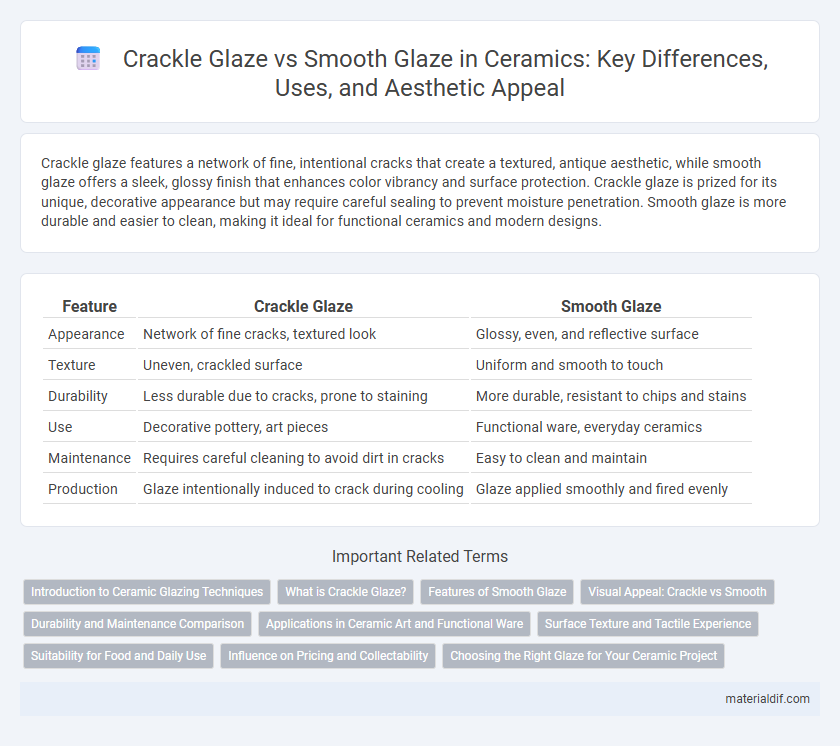Crackle glaze features a network of fine, intentional cracks that create a textured, antique aesthetic, while smooth glaze offers a sleek, glossy finish that enhances color vibrancy and surface protection. Crackle glaze is prized for its unique, decorative appearance but may require careful sealing to prevent moisture penetration. Smooth glaze is more durable and easier to clean, making it ideal for functional ceramics and modern designs.
Table of Comparison
| Feature | Crackle Glaze | Smooth Glaze |
|---|---|---|
| Appearance | Network of fine cracks, textured look | Glossy, even, and reflective surface |
| Texture | Uneven, crackled surface | Uniform and smooth to touch |
| Durability | Less durable due to cracks, prone to staining | More durable, resistant to chips and stains |
| Use | Decorative pottery, art pieces | Functional ware, everyday ceramics |
| Maintenance | Requires careful cleaning to avoid dirt in cracks | Easy to clean and maintain |
| Production | Glaze intentionally induced to crack during cooling | Glaze applied smoothly and fired evenly |
Introduction to Ceramic Glazing Techniques
Crackle glaze features a network of fine, intentional cracks that create a textured, antique appearance, enhancing the ceramic piece's visual complexity. Smooth glaze offers a sleek, glossy finish, providing a uniform surface that emphasizes color depth and durability. Both glazing techniques influence the aesthetic and functional qualities of ceramics, with crackle glaze often used for decorative effects and smooth glaze preferred for practical use.
What is Crackle Glaze?
Crackle glaze is a decorative ceramic finish characterized by a network of fine surface cracks intentionally created during the cooling process to enhance aesthetic appeal. This glaze differs from smooth glaze, which forms a uniform, glass-like surface without cracks, providing a sleek and glossy finish. Crackle glaze is valued for its unique texture and vintage look, often used in pottery, tiles, and art pieces to add depth and visual interest.
Features of Smooth Glaze
Smooth glaze on ceramics provides a sleek, glass-like surface that enhances durability and resistance to scratches and stains. It creates a uniform, reflective finish that highlights the underlying clay body or decoration with vivid clarity. This glaze type is favored for functional pottery and tableware due to its easy-to-clean, non-porous surface.
Visual Appeal: Crackle vs Smooth
Crackle glaze features a network of fine, intentional surface fissures that create a textured, antique aesthetic, enhancing visual complexity and depth in ceramic art. Smooth glaze offers a sleek, glossy finish that emphasizes vibrant colors and a polished, modern look with uniform reflectivity. The choice between crackle and smooth glaze significantly influences the ceramic piece's visual appeal, balancing rustic charm against refined elegance.
Durability and Maintenance Comparison
Crackle glaze, characterized by its network of fine cracks, tends to be less durable due to its susceptibility to moisture infiltration and staining, requiring careful maintenance to preserve its appearance. Smooth glaze offers superior durability with a dense, non-porous surface that resists scratches, stains, and chipping, making it easier to clean and maintain over time. When selecting between the two, smooth glaze is preferred for high-traffic or functional ceramics due to its long-lasting resilience and minimal upkeep.
Applications in Ceramic Art and Functional Ware
Crackle glaze, characterized by its network of fine surface cracks, is prized in ceramic art for its aesthetic appeal and unique texture, often enhancing decorative pieces and traditional pottery. Smooth glaze provides a sleek, glass-like finish that is favored in functional ware for its ease of cleaning, durability, and resistance to liquids, making it ideal for everyday use such as dinnerware and kitchen tiles. Artists and artisans select crackle glaze to emphasize visual complexity and handmade qualities, while smooth glaze suits practical applications requiring hygiene and longevity.
Surface Texture and Tactile Experience
Crackle glaze features a network of fine surface fissures that create a textured, intricate pattern, enhancing visual depth and tactile interest. In contrast, smooth glaze offers a glossy and even surface, providing a sleek and polished feel that emphasizes fluidity and continuity. The tactile experience of crackle glaze is subtly uneven and engaging, while smooth glaze delivers a consistent, slippery touch ideal for minimalist aesthetics.
Suitability for Food and Daily Use
Crackle glaze features intentional fine cracks that can harbor bacteria, making it less ideal for food storage or daily utensils compared to smooth glaze. Smooth glaze creates a non-porous, easy-to-clean surface, ensuring better hygiene and durability for everyday use. For food safety and maintenance, smooth-glazed ceramics are generally more suitable in kitchens and dining settings.
Influence on Pricing and Collectability
Crackle glaze pottery often commands higher prices due to its unique network of fine surface cracks, which collectors prize for its aesthetic texture and historical authenticity. Smooth glaze pieces, while typically less expensive, appeal to buyers seeking sleek, uniform finishes and durability, influencing market demand differently. The rarity and visual complexity of crackle glazes enhance collectability, making them a favored choice among enthusiasts and driving up secondary market values.
Choosing the Right Glaze for Your Ceramic Project
Crackle glaze offers a distinctive network of fine fractures that enhances the visual texture and antique appeal of ceramics, making it ideal for decorative pieces and rustic designs. Smooth glaze provides a sleek, glass-like finish that is durable, easy to clean, and perfect for functional pottery such as dinnerware and kitchenware. Selecting the appropriate glaze depends on the desired aesthetic effect, surface texture, and intended use of the ceramic project.
Crackle Glaze vs Smooth Glaze Infographic

 materialdif.com
materialdif.com